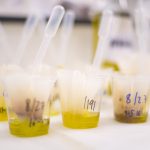MOSH and MOAH and other vegetable oil contaminants
Indlab is one of just a handful of Spanish laboratories equipped for the detection of these vegetable oil contaminants.
In addition to common heavy metals, pesticides and benzopyrenes, we are also able to detect other compounds, including MOSH and MOAH, phthalates, 2-3 MCPD esters, and glycidyl ethers.
Indlab, a laboratory specialised in vegetable oils, has studied these contaminants and has successfully applied methods for their accurate analysis. This makes us one of very few laboratories in which the sector is able to control the presence of MOSH and MOAH, 2-3 MCPD esters, glycidyl esters and phthalates, amongst other more common contaminants, such as pesticides, aromatic polycyclic hydrocarbons (benzopyrenes) and heavy metals.
Our technical expertise with regard to contaminants and residues has earned us the recognition of the International Olive Council. We are one of 7 laboratories in the world that has succeeded in demonstrating our expertise in all the areas evaluated by the IOC – advanced physical-chemical analysis, contaminants and residues, and sensory analysis.
Interest in the detection and control of these emerging contaminants on the rise in the sector.
At a commercial level, the absence of these contaminants is increasingly sought after by bottlers and importers, thus producers, exporters and other stakeholders, take all necessary precautions to avoid the presence of such materials.
MOSH and MOAH
MOSH-MOAH are mineral oils which, according to the European Food Safety Authority, are hazardous to human health. The European Union therefore recommends their monitoring and control. The contamination of vegetable oil with the compounds may be caused, amongst other reasons, by the lubricants on the machines used during the harvesting and production of the oil itself.
PHTHALATES
Phthalates are found in plastics and can contaminate the oil through the use of hoses, tubes and packaging. These compounds are used to add flexibility to plastic and are not suitable for use with foodstuffs on account of their carcinogenic potential.
2-3 MCPD ESTERS AND GLYCIDYL ESTERS
We have succeeded in applying another method for the detection of 2-3 MCPD esters and glycidyl esters. The European Union recommends the control of these compounds on account of their carcinogenic potential. Their origins can be traced back to the processing and refining of these edible oils.







